Incredibly original 1963 Bedford CA Dormobile
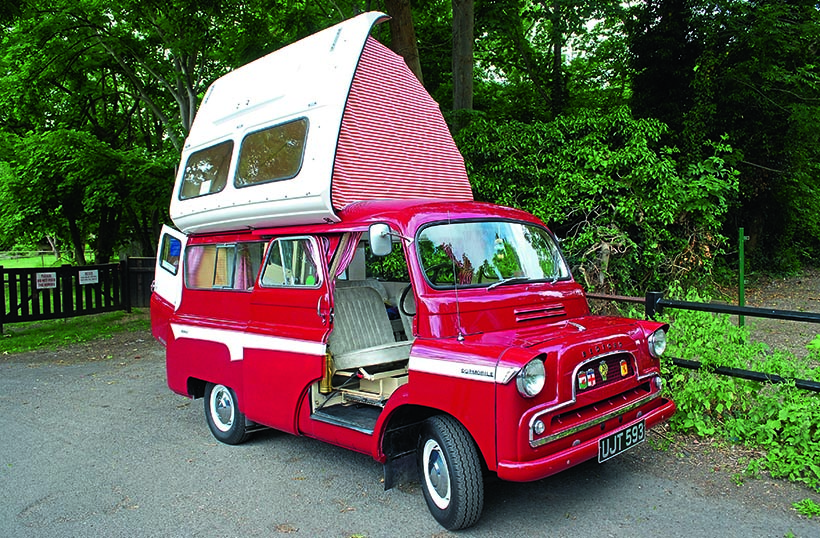
Posted by Chris Graham on 29th March 2023
Mike Neale enjoys meeting Jim Richardson and his remarkably original and prize-winning 1963 SWB Bedford CA Dormobile.
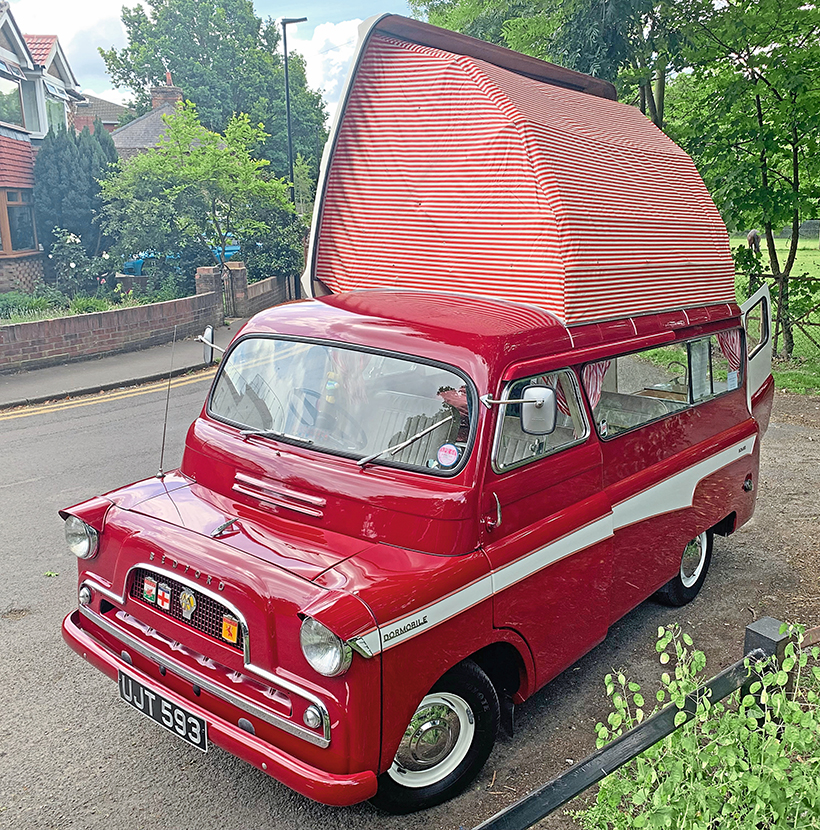
Jim Richardson’s superb, prize-winning 1963 SWB Bedford CA Dormobile.
There are some brand names that enter the English language to be used to describe anything similar, such as ‘Hoover,’ for example. Another is ‘Dormobile,’ commonly used to refer to any camper van, or even any Bedford minibus. An amalgamation of the Latin dormire, meaning to sleep, and mobile, Dormobile was actually a brand name of Martin Walter Ltd. of Folkestone in Kent, first appearing on the Bedford CA in 1952.
Early examples of their “Bedroom on Wheels” just had rear side windows fitted and folding Dormatic seats which could convert to beds when required, but no other camping facilities.
Dormobile Caravan conversions were carried out on many different base vehicles, including the BMC J2, J4, 250JU, Sherpa, Standard Atlas, Commer PA/PB, Ford Thames 400E, Ford Transit, Land Rover, Bedford CF, Fiat 850T/900T, Toyota Hi-Ace and Volkswagen Type 2. Smaller vans included the Morris Minor, Bedford HA, Austin A55 and Ford Escort.

Jim’s grandson Harry demonstrating the upper bunk beds; this photograph was taken four years ago and he’s now somewhat bigger…
It is, though, the Bedford CA that’s most closely associated with Dormobile. Besides campers, Martin Walter also produced minibus conversions of the CA, the Utilabrake, Utilicon, Utilabus and Workobus, as well as mobile shops and pick-ups.
From 1957, fully fitted Bedford Dormobile Caravans were available with their distinctive patented stripey side-hinged rising roof. These early ones had a porthole window in each rear side panel and a smaller rising roof section than later versions. They were marketed as joint products of Vauxhall Motors Ltd. and Martin Walter Ltd.
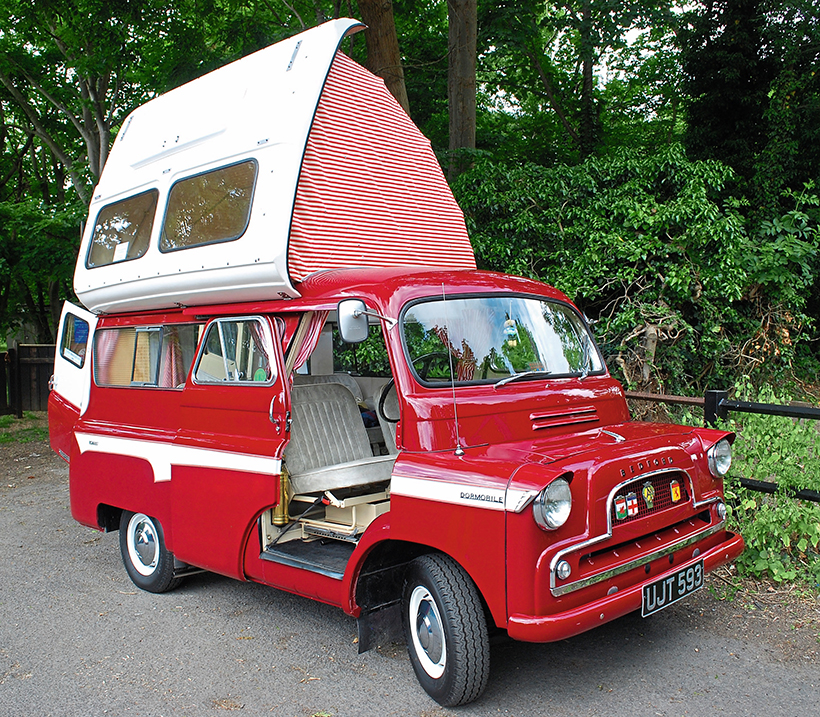
Martin Walter Dormobile, complete with operational elevating roof! Conversions based on the SWB CA – identifiable by shorter length and smaller windows in cab sliding doors – were relatively unusual.
Base vans were sent by direct rail link from Vauxhall’s Luton factory to Martin Walter’s huge site in Tile Kiln Road Folkestone. In 1959 alone, Martin Walter converted 10,000 Bedford CA vans into minibuses or caravans. The name of the manufacturing side changed to Dormobile Ltd. in 1969, and in 1973 they were taken over by the Charringtons Group. By 1991 however, Dormobile had been hit by rising raw materials costs, competition from other firms and the increasing popularity of cheap, foreign package holidays, and they went into receivership. The Folkestone factory was taken over later in 1991, but in 1994 it finally closed down.
However, 1997 saw the dawn of a new era, with the brand being purchased by a new venture. Dormobile Ltd., based in Lyndhurst in Hampshire, specialising in the restoration of original Dormobile Caravans, supplying parts to keep them going made from original Martin Walter drawings and carrying out conversions on modern vans. See: dormobile.co.uk.

Engine access via the ‘bonnet’ is restricted and really only suitable for fluid level checking; most servicing and repairs are done via the engine cover in the cab.
The first Bedford CA vans had a 10/12cwt payload, 90in. wheelbase and a 1507cc four-cylinder petrol engine from the Vauxhall E-Series Wyvern. In 1957 this was replaced by the 1507cc engine from the new Vauxhall Victor F-Type.
In 1959, Bedford facelifted the CA with a new single piece windscreen in place of the previous splitscreen and a new grille. A long wheelbase version of 102in. was also offered, designated the CAL, with the 90in. wheelbase versions then being known as the CAS. 10/12cwt and 15cwt versions of both the CAS and CAL were available, with heavier duty rear springs on the 15cwt. From 1960 a four-speed all-synchromesh gearbox was offered.
In 1964, the CA was restyled again with a larger windscreen, pressed alloy grille and the 1594cc Vauxhall Victor FB engine, with this third generation being slightly illogically called the Mk2, remaining in production until replaced by the CF in 1969.

Second-generation CAs had a small radiator grille. The badges were added by previous owner.
The CA Dormobile you see here dates from 1963. At that time Martin Walter offered three specifications of Dormobile Romany conversion on the Bedford CA: the ‘Standard’ (two-berth model with no rising roof) costing £650 on the 90in. chassis or £675 on the 102in.; the ‘Super’ (with a rising roof, contrasting sideflash and headlamp peaks) costing £775 for a two-berth 90in., £790 for a four-berth 90in., £815 for a two-berth 102in. or £830 for a four-berth 102in.; and the ‘De-Luxe’ (with a rising roof, rear window louvres, chrome bumpers and revised body styling with mini GRP tailfins), available only on the 102in. chassis, costing £880 for a two-berth or £895 for a four-berth. A three-speed gearbox was standard with four-speed an option.
This is thus a Bedford CAS Dormobile Romany Super four-berth, on the 90in. chassis, fitted with its original 1507cc Victor engine and 3-speed column change ‘box.
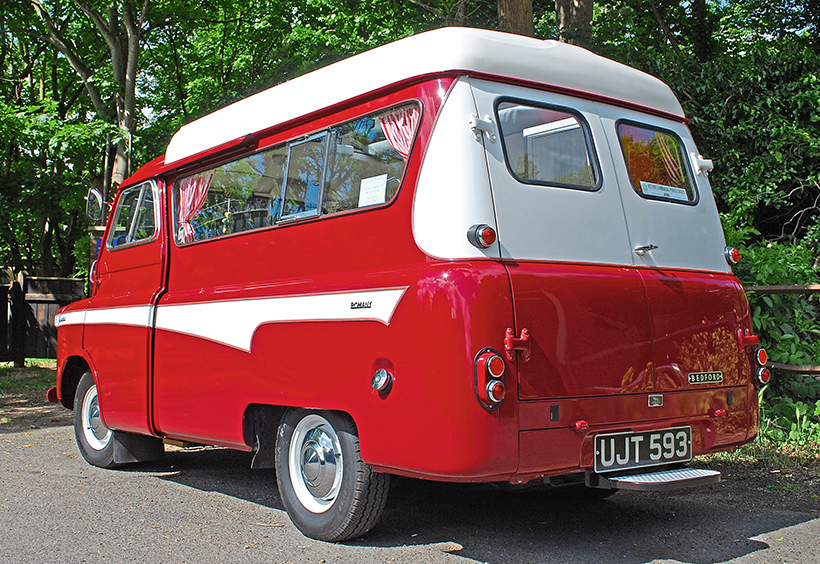
The rear end treatment of the Super version is like the regular CA, without the fibreglass fins of the De-Luxe.
It has been owned by Jim Richardson – who we met in the September 2022 issue with his Morros Minor Van – since 2015, and Jim is only its third owner. The first, from Wembley, bought it in May 1963 from Wilson’s Motor Caravan Centre in Acre Lane, Brixton, although for some reason it has a Dorset registration. He kept it 46 years, up until 2009. It was in regular use until 1982, though it had only covered 28,700 miles by then. It hadn’t been used for several years when it was sold to second owner, Albert.
It was discovered by a friend of Albert’s who had been called upon to clear several old cars that were rotting away in the garden of the first owner’s house. Some were quite rare in the UK, including a Simca Aronde, but they were good only for scrap. After these had been cleared, the owner’s wife said, “What about the garage?” It was piled high with rubbish and took half a day to empty it, but that revealed the CA camper in the back corner. Both the paint and the tyres were flat, but the latter could be pumped up. Albert was alerted and came to pull it out of the garage. In the meantime, the paperwork had been found, and Albert bought it on the spot.
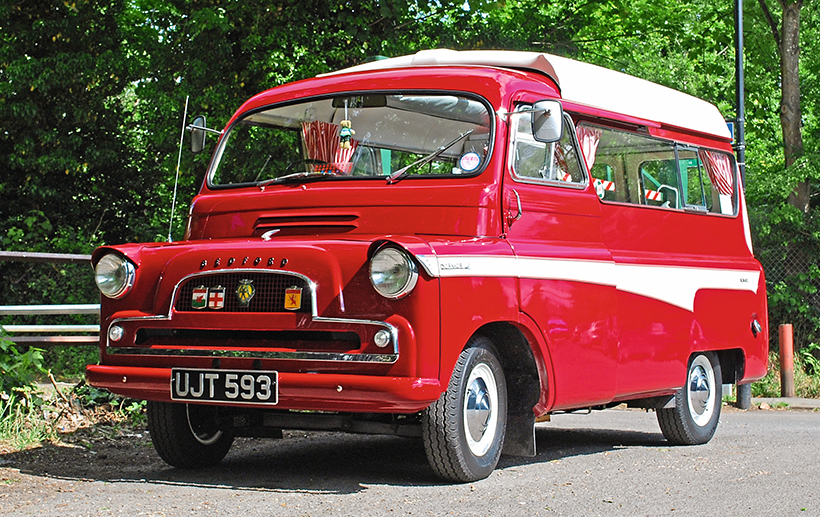
With the roof down, the camper is only slightly taller than the base CA van.
Getting it home, Albert found that there was virtually no rot on it, apart from a small amount on the front offside wheelarch. He had the Bedford resprayed in its original colour scheme of Imperial Crimson with a Dormobile White side-flash. This was done by a classic car painter and signwriter friend, Michael (Tel. 07901 720923).
The bumpers had been painted silver, but were repainted in crimson to match the body, which is correct original spec. for a Dormobile Romany Super. The original grey Vynide interior trim cleaned up remarkably well with no tears or damage, as did the Formica fittings, cooker and sink.

The cab, seen from a standing position, is very original; all the vinyl cleaned-up well.
The front and rear seats fold down to form two full length beds, which can also be slid together to form a double bed. The third and fourth berths are provided under the raised roof by rolling out canvas beds either side.
When Albert decided to sell the Dormobile in August 2015, Jim had arranged to view the van, but hit heavy traffic and arrived late, by which time it had started to rain. “It’s not going out in the rain,” Albert insisted. Jim looked around the van and asked to fire it up. “It’s not going out in the rain,” Albert reiterated. The engine started first time and sounded sweet. Jim then asked if it was ok for him to drop the clutch. “It’s not going out…” (you get the drift). Jim sensed that the engine was going to stall, and so determined that the clutch was fine.
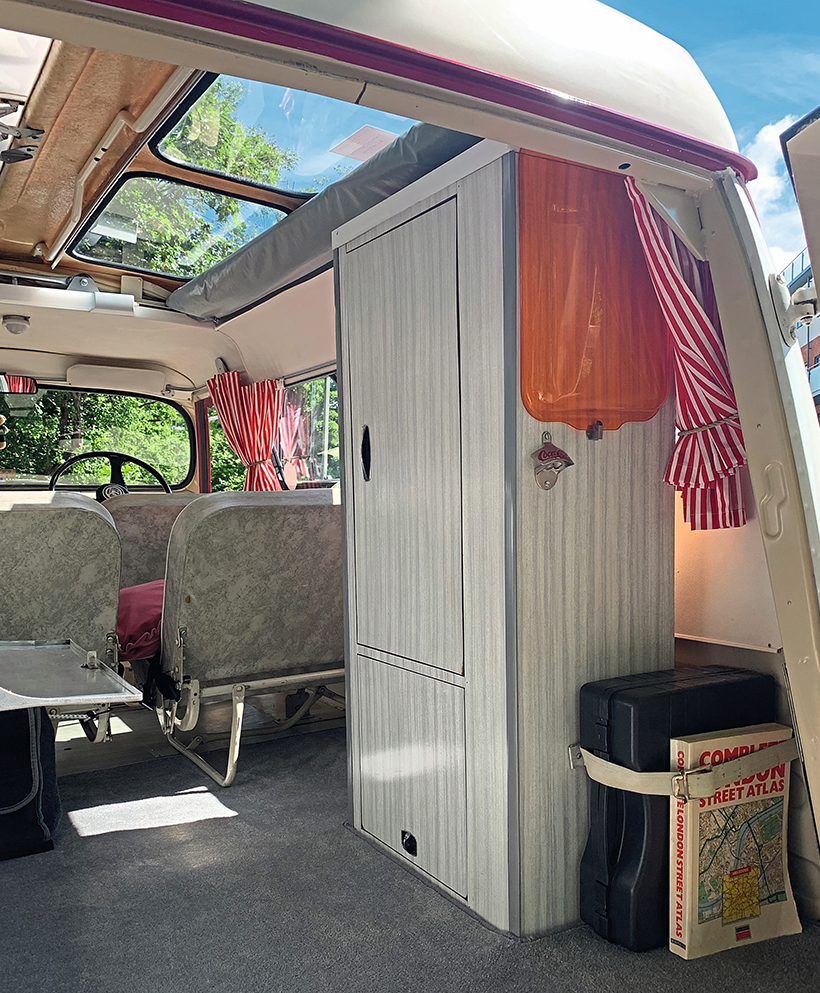
The floor covering has been renewed, otherwise the camper’s interior is mainly well-preserved original material from 1963.
“OK, I’ll take it,” Jim announced. “Don’t you want to test drive it first?” asked Albert. “Well, I can’t take it out as it’s raining, but you’ve said that it’s good and I’ll take your word for it.” Albert put a new battery on the van, but noted that a new exhaust was needed, and knocked £500 off the asking price.
After buying the van, Jim found that it was indeed a good ‘un. He bought a new stainless-steel exhaust but other than that, the Bedford is exactly as it was when he got it. There was, however, a nervous moment when he first arrived home, as the height of the Dormobile with the roof lowered is very close to the height of Jim’s garage doors. Fortunately, it just fits in with an inch to spare.
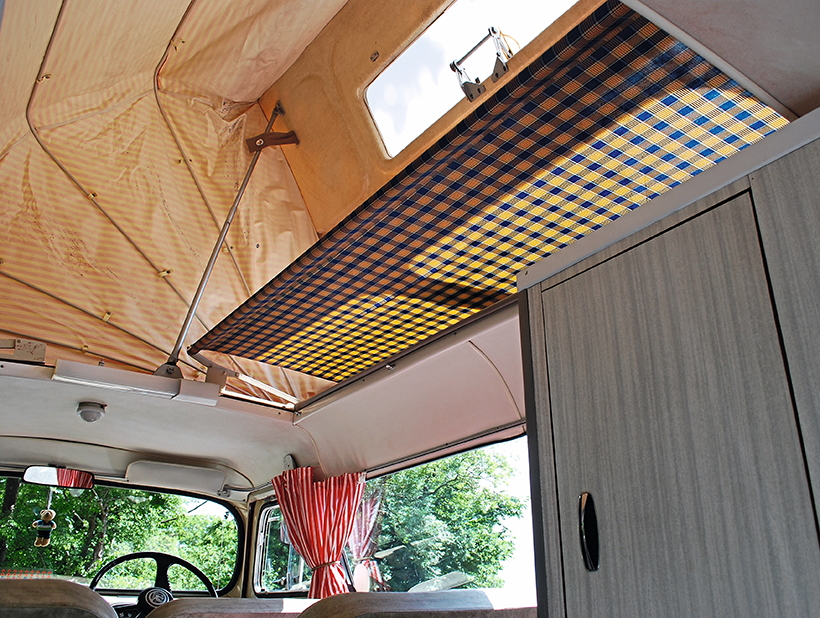
The sleeping compartment, viewed from down below.
Surprisingly, a heater was an optional extra, and this van never had one fitted. “The heat coming from the engine cowl keeps the inside pretty warm, though,” notes Jim.
Even now the Bedford has only done just over 31,000 miles. It is quite unusual as a short-wheelbase CAS Dormobile, as most people went for the long-wheelbase CAL version. Jim takes it out to shows, and was rewarded last year with the Best Bedford award on the 2022 HCVS London to Brighton run.
This feature comes from the latest issue of Classic & Vintage Commercials, and you can get a money-saving subscription to this magazine simply by clicking HERE

Previous Post
Classic commercial shelf-sized scale models to collect
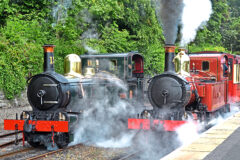
Next Post
Trams, steam engines and buses on the Isle of Man



